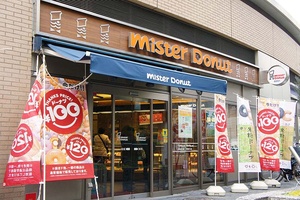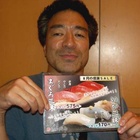So far. The Mister Donut where I’m sitting has been a good metaphor for my experience in Sendai. It was the music, the Golden Oldies that were so important to me when I was growing up in the ‘70s, that lured me into here, like a siren call.
“Kohi, kudasai” (coffee, please)…it has taken me a while to get used to looking at faces like my own. I like it! We are a good-looking people. I am still dealing with the ability to lose myself in a crowd. How I relate to my experience has been fundamentally unsettled, but how exactly I still can’t figure. Westerners and Europeans stand out here in the same way I do in Canada. It really is difficult not to stare.
One of my pet peeves is seeing so many Europeans in Japanese clothing ads. We talked about it in the class last week. When I posed the question, “Why are there so many hakujin in Japanese clothing ads?,” one student replied, “Because they have longer legs and look better in clothes.” Perplexed, I said, “But you are not blond, blue-eyed, or European?” I suspect this is a petty Sansei gripe here in Japan but in Canada or the U.S. where there isn’t much of a positive Nikkei self image, the ideals of beauty and symmetry aren’t our own. When is the last time we looked closely at ourselves in the mirror? Thinking about this later, I considered that Japanese appreciation for Western image and exotica is no different than westerner’s clichéd ideas of Asia. I’ve yet to see a westerner advertise kimonos, though.
…I like the music playing here, Fats Domino is pumping our “When the Saints Go Marching In” on WBNE Radio Boston, halfway around the world, in a culture that’s a hybrid of east and west, like me. At home, I do not seek out donuts shops, but it does help take away a little of the edge of my homesickness; one less foreign thing to deal with in this foreign land, I guess.
Evidence of U.S. pop culture is everywhere. I don’t know how deeply these changes have steeped here in Sendai where almighty franchises like McDonalds, Pizza Hut, 7-11, and Mister Donut are still out-numbered by ramen shops. The nihon-jin craving for junk food seems to be like a passing adolescence phase. The only large, fat people here are sumo wrestlers! As Fats (no pun intended) rages on, Mister Donut is filling up with a young after school and work crowd, flipping through comic books, eating small 100 yen donuts.
I’m finally beginning to get into a rhythm of sorts. I began teaching at the Language Service Centre on my second day in Sendai. Within a week I was living in my own house in Kitayama. It is spacious: two fresh smelling tatami rooms, hardwood floors in a third room, and a kitchen. There’s a Japanese bath and separate toilet. Rent is 52,000 yen a month, including utilities. I paid three months rent for the real estate agent who arranged the deal. Quite an outlay of cash.
We, English teachers, are a transient bunch. A few teachers left recently, I’m the newest teacher, Dana-Lyn, a native of Steveston, B.C. started a few weeks before me. I landed in Sendai with three bags filled with clothes, teaching materials, and gifts. The house is empty except for a few generous offerings from co-workers and choice items from the spring cleaning piles of trash. What is really missing here is Karen.
…a free refill! I’m beginning to feel my first Japanese coffee buzz; getting “beaned” as we say on the west coast. Caffeine and now the shangri-la. It’s a heady combination.
…aikido has taught me to pause whenever things get too tense and take a deep breath and let go, resigning myself to whatever will be. Ever since receiving notice that I landed this teaching job at Maruzen a number of coincidences worth repeating took place. Two weeks ago before leaving for Japan, David Edginton joined the Kootenay aikido dojo, coming directly from Sendai and the dojo at Tohoku Fukushi University where I hoped to train. Yesterday I stopped in at a used bookstore, browsed around, didn’t see an English book section. I was about to leave when a photograph on the cover of a book drew me towards it.
I picked it up because something seemed to twig, beginning to turn the pages, returning to the front where, lo and behold, there was a map of Canada. The photo that beckoned me was one of Isseis who immigrated to Canada! I paid 500 yen for it and counted my luck for finding it. Enough cynicism.
I know that the image of Japan that I grew up with was an ambiguous, mostly negative one. My brief experience here has been the contrary. I was expecting the worst. Instead of feeling any sense of rejection, I feel embraced here, a part of the culture which seems as curious about who I am as I am of them. The European gaijin seem the most confused and concerned about where to “slot” me.
The New York senator’s racist remarks directed at Judge Lance Ito of the O.J. Simpson trial was big news in Japan. It was a somewhat disheartening reminder of the complex nature of identity which, along ethnic lines, seems to have really become a pressing issue in North America in the 1990s. For Nikkei born in Canada or the U.S., we’re torn between two images of Japan, two histories, generations of racist propaganda that have warped, mutated, and maligned the self image of generations of Japanese descendants. WHEW! What a lot to deal with.
I’m reminded by a recent Japan Times article about Japanese immigrants from Mie that we are not a very well understood minority. Riddled with historical errors (i.e., 50,000 nikkei were affected by the evacuation), I worry how the Issei are remembered here in Japan. Perhaps it’s our own fault for not speaking up and being more assertive in the creation of a positive self-image. Certainly, little has been done in the post-World War II era to repair this damage.
Many Nisei I know have an uneasy relationship with Japan which unfortunately has been passed on to subsequent generations who feel even further removed from their roots. Our forefathers brought no shame onto the legacy they left us, immigrating to North America at a time in history when an impoverished Japan was just beginning to emerge from its self-imposed isolation.
Japan’s mania to learn English, gobble junk food and western pop culture make this a very accessible place especially for those of us who are Nikkei. We are in a unique position to bridge the two cultures. To an extent, we’re still unclear about who we are, giving ourselves over too freely to the “blond, blue-eyed” myth, disconnected from our cultural and language roots whose critical importance has been underestimated by our leaders. We have a place in Japan—a birthright—even if it’s as welcomed visitors.
The world is a rapidly changing place and Japan is as caught up in this mad evolution as any country. As a sansei E.S.L. teacher living in Japan, trying to expand my understanding about who I am, I too feel caught up in this revolution of identity that seems to be in some kind of mystical accord with the land of my ancestors.
I will take one of those deep breaths right now.
* This article was originally published in Nikkei Voice in May 1995.
© 1995 Norm Ibuki







